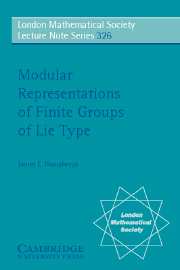Book contents
- Frontmatter
- Contents
- Preface
- 1 Finite Groups of Lie Type
- 2 Simple Modules
- 3 Weyl Modules and Lusztig's Conjecture
- 4 Computation of Weight Multiplicities
- 5 Other Aspects of Simple Modules
- 6 Tensor Products
- 7 BN-Pairs and Induced Modules
- 8 Blocks
- 9 Projective Modules
- 10 Comparison with Frobenius Kernels
- 11 Cartan Invariants
- 12 Extensions of Simple Modules
- 13 Loewy Series
- 14 Cohomology
- 15 Complexity and Support Varieties
- 16 Ordinary and Modular Representations
- 17 Deligne–Lusztig Characters
- 18 The Groups G2(q)
- 19 General and Special Linear Groups
- 20 Suzuki and Ree Groups
- Bibliography
- Frequently Used Symbols
- Index
13 - Loewy Series
Published online by Cambridge University Press: 23 November 2009
- Frontmatter
- Contents
- Preface
- 1 Finite Groups of Lie Type
- 2 Simple Modules
- 3 Weyl Modules and Lusztig's Conjecture
- 4 Computation of Weight Multiplicities
- 5 Other Aspects of Simple Modules
- 6 Tensor Products
- 7 BN-Pairs and Induced Modules
- 8 Blocks
- 9 Projective Modules
- 10 Comparison with Frobenius Kernels
- 11 Cartan Invariants
- 12 Extensions of Simple Modules
- 13 Loewy Series
- 14 Cohomology
- 15 Complexity and Support Varieties
- 16 Ordinary and Modular Representations
- 17 Deligne–Lusztig Characters
- 18 The Groups G2(q)
- 19 General and Special Linear Groups
- 20 Suzuki and Ree Groups
- Bibliography
- Frequently Used Symbols
- Index
Summary
The internal structure of indecomposable projective modules encodes, among other things, the possible extensions between simple modules (12.1). In Chapter 12 we looked closely at the Ext functor for finite groups of Lie type. Here we consider the broader question of describing the Loewy series of PIMs (13.1), which in principle can yield minimal projective resolutions of all simple modules (13.4).
Even though Loewy series for groups of Lie type have been worked out in detail only for SL(2, q) (see 13.5) and a few isolated groups of higher rank surveyed at the end of the chapter, the study of closely parallel theories in characteristic 0 (13.6) and characteristic p (13.7) suggests a natural candidate for the “generic” Loewy length of PIMs for KG when G is a finite group of Lie type over a field of pr elements. This should be 2rm + 1, where m = |Φ+|.
Assuming the truth of Lusztig's Conjecture (3.11), Pillen exploits for finite Chevalley groups when r = 1 an embedding of principal series modules into Weyl modules (13.10) to prove that the generic Loewy length of PIMs is indeed uniform: 2m + 1 (13.11). This is in striking contrast to the fact that generic dimensions of PIMs typically vary from alcove to alcove for restricted weights. (Similar results are expected for r > 1 and for twisted groups, with generic Loewy length 2rm+1.)
- Type
- Chapter
- Information
- Modular Representations of Finite Groups of Lie Type , pp. 129 - 142Publisher: Cambridge University PressPrint publication year: 2005

